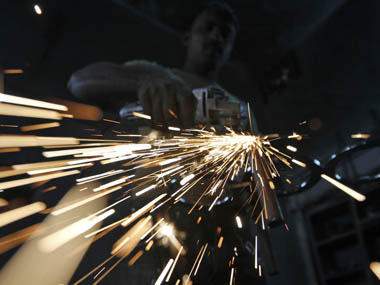Data released by the government on Monday showed some improvement in India’s industrial output numbers for the month of November. The Index of Industrial Production (IIP) grew at 3.8 pecent in November — the highest pace in five months — after registering a disturbing 4.2 percent drop in the previous month. Most of the internals in the factory output numbers showed revival, albeit mild, except in consumer goods and consumer durables. Capital goods and manufacturing, two critical parameters mirroring fresh corporate investments and the economic activity on the ground, grew 6.5 percent and 3 percent after registering a decline of 2.3 percent and 7.6 percent, respectively, in the preceding month. Pace of growth in mining and electricity generation have declined slightly to 3.4 percent and 10 percent in November from 5.2 percent and 13.3 percent, respectively. [caption id=“attachment_2043047” align=“alignleft” width=“380”]  Reuters[/caption] The bad performer in the index was consumer goods and consumer durables, where growth slumped by 2.2 percent and 11.5 percent, even though the pace of decline in these segments has moderated somewhat from October numbers. On the whole, theoretically, the November IIP numbers should give some comfort to the Narendra Modi government as the numbers show an improvement in the overall economic scenario, manufacturing and fresh investments in particular. Corporations may have begun investing and project implementation scenario may be looking slightly better. But another set of numbers on fresh loan recasting under the CDR channel, Firstpost has access to, paint a somewhat discouraging picture regarding the corporate health — something that is a continuation of the prolonged economic slowdown and slow decision making during last one decade. Even as the number of fresh references to the CDR has come down in three months ended December, the number of companies which were taken out of the mechanism on account of failure rose significantly highlighting the persisting stress on the health of corporations. CDR is a mechanism under which banks offer relaxed repayment terms to troubled companies by elongating repayment period, reduced lending rates, repayment holiday (moratorium) or even a sacrifice in some cases. A CDR deal takes place if majority lenders in the forum agree to the deal. A total of 10 cases were referred to the CDR cell in the December quarter with loan amount totalling to Rs 7,000 crore compared with Rs 13,313 crore in the September quarter from 14 cases, according to data available from the CDR cell. This includes the Rs 7,000-8,000 crore loan recast proposal of Pipavav Defence & Offshore Engineering. On the other hand, about 35 cases worth Rs 20,000 crore failed on account of inability to revive operations or lack of compliance with regulations in the December quarter, while just two firms managed to exit successfully. “Most of these loans are likely to become non-performing assets (NPAs),” said a senior official at the CDR cell. As against this, in the September quarter, as many as 14 cases with total loans amounting to Rs 8,356 crore worth loans were taken out of the CDR mechanism due to failure. With this, the total loans currently being restructured under the CDR mechanism would have crossed Rs 3 lakh crore as of end December. Besides this, banks also recast loans on a bilateral basis. Although the aggregate amount of loans recast under this channel is not available, it is estimated to be somewhat equal to the CDR chunk. That would take the total amount of recast loans in the banking system to over Rs 6 lakh crore. This, combined with the gross bad loans in the industry, about Rs 2.7 lakh crore, would take the total stressed assets in the system about 14 percent of the total loans given by banks. Rising pain on the balance sheets of banks impacts their profitability since these banks need to set aside more money to cover such loans. For a newly restructured loan, banks need to make a fresh provision of 5 percent. On the other hand, for a loan that has fully gone bad, the provision amount can be as high as 100 percent. Most worryingly, persisting stress in the banking system can delay the economic recovery process since banks will be reluctant to take fresh exposure to companies until banks clean up their balance sheets. The problem will be particularly severe with state-run banks, which have over 90 percent of the bad loan share. Unless banks resume lending to large projects, a recovery is difficult to take strong root in Asia’s third largest economy. The situation is not very encouraging as of now since banks haven’t made any meaningful lending to companies in last two years for fresh projects as reflected in the RBI data. To make sure economic revival is real, thus, the Modi government and the central bank will have to work on both sides of the problem almost simultaneously — repairing the stress on corporate balance sheets and bringing in fresh investments. There is no middle path. (Data support from Kishor Kadam)
To make sure economic revival is real, thus, the Modi government and the central bank will have to work on both sides of the problem almost simultaneously
Advertisement
End of Article


)

)
)
)
)
)
)
)
)



